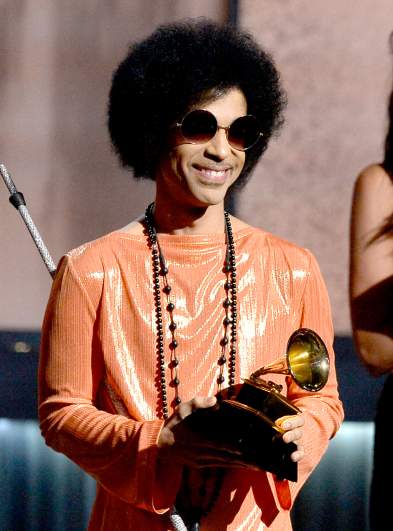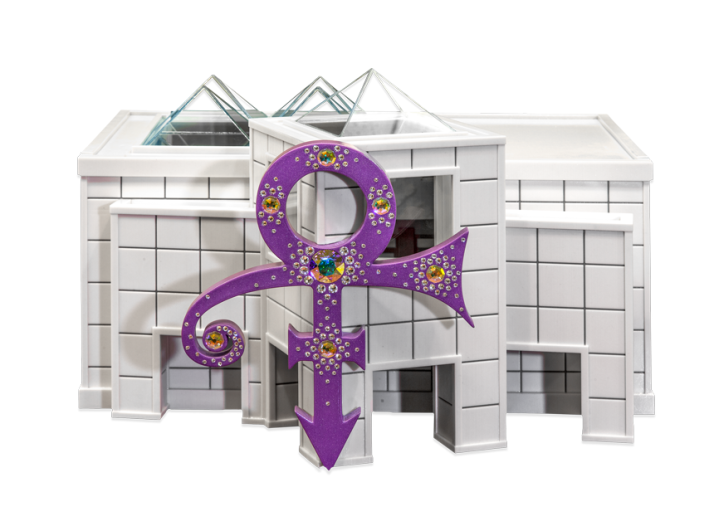
Getty Prince performs onstage at Warner Theatre on June 14, 2015 in Washington, DC.
Prince Rogers Nelson, better known to the world as the iconic superstar Prince, died four years ago at the age of 57 from an accidental fentanyl overdose. His death on April 21, 2016, shocked the world, with fans and celebrities sharing their grief and disbelief on social media, at his home Paisley Park and in cities around world.
Prince came onto the scene in the late 1970s, making his mark by the 1980s with hit songs like “When Doves Cry, “Purple Rain” and “Little Red Corvette.” He won seven Grammy Awards and was nominated for 38 more. The private and mysterious musician was known as much for the way he used sexuality in his music as he was for his guitar prowess. Though Prince’s stature was small, his presence was huge. He seemed to naturally command reverence.
In the months before he died, Prince was exploring sharing more about himself with the public. He’d been working with author Dan Piepenbring on a biography of his life to be titled The Beautiful Ones, and he’d embarked on a pared-down solo tour called Piano and A Microphone. According to The Beautiful Ones, which was published in 2019, “The show wove storytelling and reflection into songs that stretched from his first record, For You,, to his most current, HitnRun Phase Two. His spoken contributions gave an idea of what was on his mind at the time. He was processing his past.”
A Piano and A Microphone show in Atlanta on April 14, 2016, was the last public show Prince would ever play. He’d canceled that Atlanta show the week prior due to illness, but he made it up to them. Prince was found dead in an elevator at his home in Chanhassen, Minnesota, at Paisley Park a week later.
Here is what you need to know about Prince’s death:
1. Prince’s Management & His Doctor Were Trying to Get Him Help for Opiate Addiction on the Day He Died
While Prince’s death shocked the world, those in his inner circle knew he needed help overcoming his dependence on pain medication. Court records and the findings of the Carver County attorney’s investigation into the superstar’s death tell a story of a downward spiral that was enabled by Prince’s entourage. Only a concerned few made efforts that turned out to be too little, too late.
In a press conference by Carver County Attorney Mark Metz in which he delivered the state’s findings, he said that on April 7, 2016, Dr. Michael Schulenberg first examined Prince for symptoms of nausea and tingling in his hands and feet. At that time Schulenberg prescribed Vitamin D and nausea medication to Prince.
On April 14, Metz said, Prince’s bodyguard and longtime friend Kirk Johnson called Schulenberg again to ask for pain meds for the singer, saying Prince had a concert in Atlanta but had hurt his back lifting equipment. Schulenberg prescribed him 15 Percocet but prescribed them in Johnson’s name at the request of Prince in an effort to protect his privacy, as the doctor had done the previous week with the prescriptions he’d giving the singer.
Late night on April 14, when Prince was flying home to Minneapolis from his Atlanta Piano and A Microphone concert, he became unconscious and the plane made an emergency landing in Illinois. Airport emergency personnel gave Prince two doses of Narcan, a drug used to reverse the effects of opiates when a person is overdosing. He went to the hospital to be checked out but refused treatment, according to court records, and was released.
Piepenbring wrote in The Beautiful Ones that a couple days later, four days before Prince died, Prince called him. He wanted to talk about ideas for the book and to tell him he was okay.
“Hi Dan, it’s Prince,” he said. “I wanted to say that I’m alright, despite what the press would have you believe. They have to exaggerate everything, you know.”
On April 18, Johnson called Schulenberg and told him he was concerned about Prince’s opiate use. On April 20, the day before Prince died, the doctor examined Prince again and, according to Metz, Prince “stated that he was feeling antsy and asked about opiate withdrawal symptoms.” Schulenberg gave Prince IV fluids, took a blood sample and prescribed clonidine, a blood pressure medication sometimes used to treat withdrawal symptoms.
That night the doctor spoke with Prince’s management about getting help for Prince’s addiction. Metz said the star’s management then reached out to a recovery center in California to make arrangements. A representative from the treatment center, Recovery Without Walls, traveled to Minnesota on April 21 to meet with the singer. That same morning Schulenberg called Johnson to tell him he had Prince’s blood test results and he was going to bring them to the house.
When Schulenberg got to Paisley Park, rescue workers were already there responding to a 911 call.
2. No One Had Seen Prince For Over 12 Hours By The Time He Was Found
Transcripts from the 911 call say that the person who made that call at about 9:45 a.m. on April 21, at first said a person was unconscious but then said, “Yeah, we have um, yeah, we have um, so, yeah, um the person is dead here.” And while that caller seemingly tried to protect the privacy of the fallen star, eventually he confirmed that Prince was the person they were calling about.
At the end of the call, a dispatcher says, “…you can cancel anybody going to Audubon, confirmed DOA” — or Dead on Arrival. Audubon is the street address for Paisley Park.
Court records show that while Prince lived alone, he often had people over. No one had seen him since about 8 p.m. the night before his body was discovered, but according to The Beautiful Ones, it wasn’t unusual for Prince to disappear for while. And while it is believed that Prince had developed a dependency on opioid painkillers, investigators do not believe Prince meant to take fentanyl, a powerful and sometimes deadly opiate.
According to the Midwest Medical Medical Examiner’s findings, Prince weighed 112 pounds when he died of accidental fentanyl toxicity. His body was cremated. Prince’s occupation is listed as simply “Artist.”
3. Investigators Do Not Believe Prince Knew He Was Taking Fentanyl

GettyMusician Prince speaks onstage during The 57th Annual GRAMMY Awards at the at the STAPLES Center on February 8, 2015, in Los Angeles, California.
Metz said the evidence demonstrates that Prince thought he was taking Vicodin and not fentanyl. Metz said the evidence showed that Prince had lived with significant pain for a long time and had been taking pain medicine for several years. He said there were many pill bottles found in the star’s home, and a “significant” number of the pills were in bottles with labels that didn’t match the drugs inside. He also said that Prince did not have a prescription for Vicodin or fentanyl.
Metz said:
The evidence suggests that Prince took counterfeit Vicodin containing Fentanyl on or about April 21, 2016. Unfortunately, the subject counterfeit Vicodin Pills are an exact imitation of real Vicodin pills but the counterfeit pills contained the potentially deadly opioid Fentanyl … Nothing in the evidence suggests that Prince knowingly ingested Fentanyl … In all likelihood Prince had no idea he was taking a counterfeit pill that could kill him.
Metz said that a sample of some of the hundreds of pills taken from Paisley Park tested positive for fentanyl. However, the attorney said that there was no evidence that anyone who knew or associated with Prince and spent time at Paisley Park knew anything about the counterfeit pills. Metz also said there was no evidence that any the pills Prince took were prescribed by a doctor. No one was ever held accountable for the singer’s accidental overdose.
“The bottom line is that we simply do not have enough evidence to charge anyone with a crime related to Prince’s death,” Metz said.
4. Prince’s Ashes Are Housed in a Specially Designed Urn That Replicates Paisley Park, Where They Are on Display to the Public

Foreverance.comPrince’s urn is a replica of his home compound, Paisley Park.
After Prince’s body was cremated, his family had an urn made especially for him. According to Foreverence, the company that designed the urn, Prince’s family said they wanted an urn in the shape of Paisley Park, with Prince’s adopted symbol in his signature color, purple, adorning the front of the building-shaped urn.
The symbol, which Prince made his name in 1993, is a combination of the astrological symbols for man and woman. Entertainment Weekly reports the singer issued a press statement when he unofficially, not legally, changed his name from Prince to the symbol, saying, “It is an unpronounceable symbol whose meaning has not been identified. It’s all about thinking in new ways, tuning in 2 a new free-quency.” Though the iconic artist eventually went back to being publicly referred to by his birth name, Prince, the symbol stuck.
After Prince’s death, Paisley Park opened to the public, offering different tour experiences at different price points (Note: The park is currently closed due to the COVID-19 pandemic). According to Foreverence, the urn is located in the main atrium, which is where visitors enter to take the tours. The company said, “visitors are given an opportunity to pay their respects to this one-of-a-kind artist.
5. Prince Had No Will & The Court Case Over His Estate Is Still Ongoing
When Prince died, Forbes estimated his assets were worth between $150 and $300 million, but he did not leave behind a will or any kind of instruction on what he wanted to happen to his estate. Court records show that people came out of he woodwork to make their claim on the artist’s money and for the rights to his intellectual property, as well as his real property.
Several claims by people that Prince was their father were never found to be viable in the courts, who early on ordered Prince’s DNA sample in anticipation that people may try to claim to be his heir. But claims of being a long lost child of the late star were not the only ways people came after his money. People came forward with all kinds of unusual stories.
A woman claiming to be his secret wife said that he also had a secret will naming her the sole heir. She claimed she helped co-write “I would die 4 u” when she was only 8-years-old in 1974; and the story gets weirder. Another man claimed that he and Prince had a $1 billion agreement they’d made in 1995 in which the man would get all of Prince’s intellectual property in the event of the musician’s death. The courts rejected both claims.
While litigation in the court case is still ongoing all these years later, ultimately six heirs were deemed to inherit his estate; his siblings. Prince had a total of seven brothers and sisters between his parents’ marriages. One brother died in 2011. Tyka Nelson is his only full-blooded sister and court records show that in November 2019 she sold her portion of the estate to Primary Wave Entertainment.
In August of 2019 another one of the heirs, Alfred Jackson, died while in the process of signing over his share of the estate to Primary Wave, according to the Minneapolis/St. Paul Business Journal.
The bank that oversees the estate, Comerica, was appointed this past March to continue to oversee the estate for another year by a Minnesota judge. The estate will pay the bank $110,000 per month according to the order.
All along it has been a messy court case. Prince’s siblings have contested the way Comerica is handling the estate multiple times.
Judith T. Younger, a law professor at the University of Minnesota who teaches estate-and-trusts law told USA Today, “It’s not unusual (because) he had complicated assets, he had a lot of money, he didn’t leave a will… His assets are hard to manage. The heirs fight among themselves. But that’s not unique, not in Minnesota or anywhere in the country.”
When Heavy reached out for comment from the bank they replied, “Comerica has no comment in connection with this matter.”
READ NEXT: Dolly Parton and Kenny Rogers: 5 Fast Facts You Need to Know
Comments
Prince Rogers Nelson’s Death: 5 Fast Facts You Need to Know